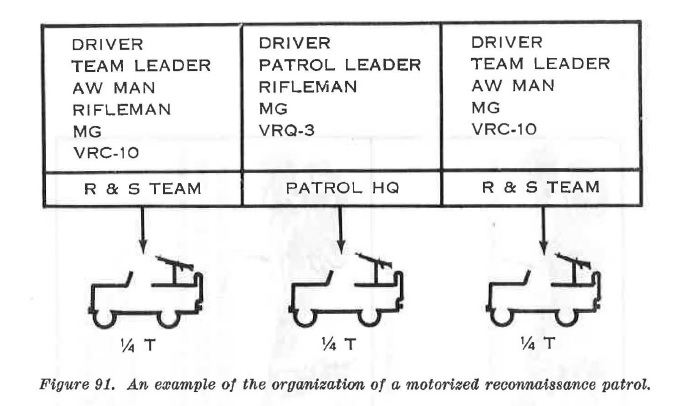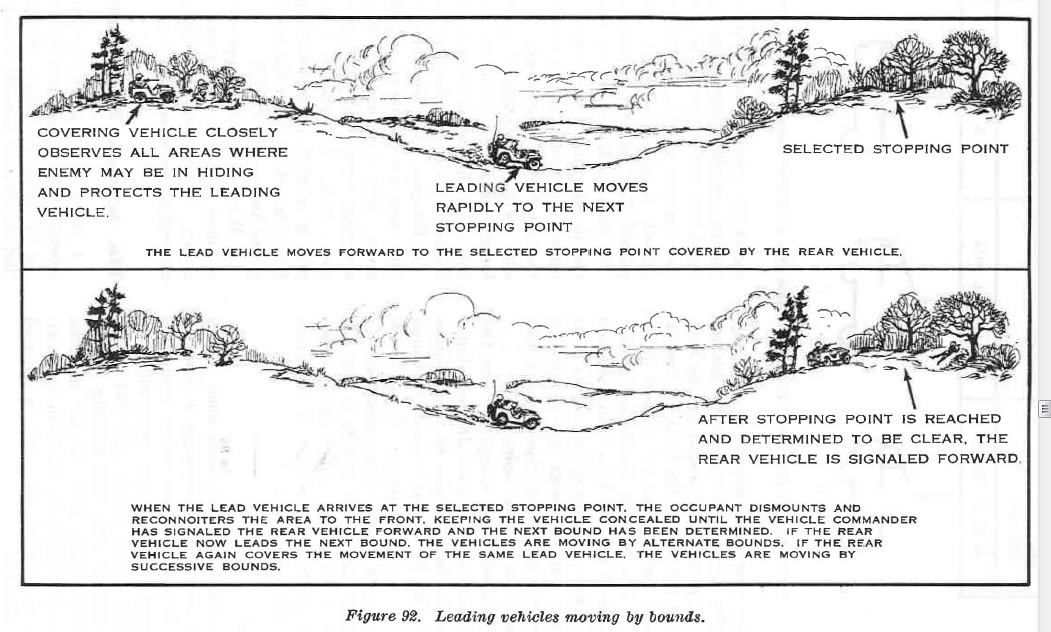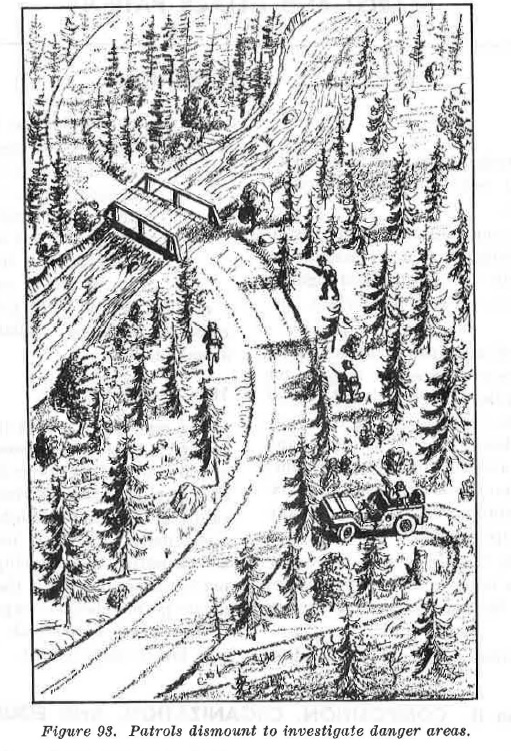Donate
| SECTION I | ---------------------------------- | GENERAL |
| SECTION I | ---------------------------------- | ENEMY CONTACT |
178. Purpose
Patrols are mounted in vehicles to allow them to:
a. Cover greater distances in less time than dismounted patrols.
b. Operate in contaminated areas too dangerous for dismounted patrols.
c. Carry more or heavier equipment, weapons, and ammunition.
179. General and Special Organization.
A motorized patrol is organized into elements and teams in the same manner as a dismounted patrol. An example of a motorized reconnaissance patrol is shown in figure 91. Substitution of tracked personnel carriers for wheeled vehicles provides an increased potential for battlefield mobility.
a. When men are assigned to vehicles, squad or fire team integrity is maintained as far as possible.
b. One man is designated to be in command of each vehicle.
180. Preparation.
A motorized patrol is prepared in the same general manner as a dismounted patrol. In addition, however, vehicles must be checked to insure that they are in good mechanical condition and properly supplied with fuel, oil, and water. Drivers and other attached men must be as thoroughly prepared for the mission as regular patrol members.
181. Equipment.
Motorizing enables a patrol to carry heavy and bulky equipment. For example:
a. Antitank weapons and ammunition. These are placed near the front and rear of the patrol. Personnel are designated to man and support these weapons when they are employed.
b. Long-range vehicular· mounted radios.
c. Surveillance equipment.
d. Additional automatic weapons and ammunition.
182. Control.
Communication between vehicles and between the patrol and higher headquarters is essential.
a. Within the patrol, radios, voice commands, and visual signals may be used.
b. Vehicular mounted radios are usually the best means for communication with higher headquarters.
c. Light aircraft may be used to drop messages and to relay radio messages.
183. Movement
A motorized patrol moves by one of three methods:
a. Continuous Movement.
All vehicles travel at a moderate rate of speed, with all personnel especially alert. The leading vehicles stop to investigate only those areas that appear particularly dangerous. This is the fastest, but least secure, method of movement.
b. Successive Bounds.
Vehicles keep their relative positions in the column. The two leading vehicles operate as a team in moving from one observation point to another (fig. 92). The second vehicle is placed in a concealed position, occupants dismounting if necessary, and covers movement of the first vehicle to an observation point. On reaching this point, occupants of the first vehicle observe and reconnoiter, dismounting if necessary. When the area is determined to be clear, the second vehicle is signaled forward to join the first vehicle. The commander of the first vehicle carefully observes the terrain to the front for signs of the enemy and selects the next stopping point. The first vehicle then moves out and the process is repeated. The bound for the leading vehicle must not exceed the limit of observation or the range for effective fire support of the second vehicle. The leading vehicle and personnel must be replaced frequently to insure constant alertness. The other vehicles in the column move by bounds from one concealed position to the next. Each vehicle maintains visual contact with the vehicle ahead but avoids closing up.

Figure 91. An example of the organization of a motorized reconnaissance patrol.
c. Alternate Bounds. All except the first two vehicles keep their relative places in the column. The first two vehicles alternate as lead vehicles on each bound (fig. 92). Each covers the bound of the other as described above. This method provides more rapid advance than movement by successive bounds but is less secure; it does not allow the men in the second vehicle enough time to thoroughly observe the terrain to the front before passing the first vehicle.
184. Security.
Security is obtained by requiring each vehicle commander to assign each passenger a direction to observe. As each vehicle moves along the route, designated occupants are responsible for observing to the front, flanks, and rear. This provides each vehicle with some security against surprise fire from every direction and provides visual contact with vehicles to the front and rear. For maximum observation, all canvas is removed from wheeled vehicles.
185. Actions at Danger Areas.
a. The commander of the leading vehicle 1mmediately notifies the patrol leader when he encounters an obstacle or other danger area. Designated men reconnoiter these places under cover of the weapons in the vehicle. Obstacles are bypassed, if possible. When they cannot be bypassed, they are very cautiously removed.
b. Side roads intersecting the route of advance are investigated. Men from one vehicle secure the road junction; one or two vehicles investigate the side road. The amount of reconnaissance of side roads is determined by the patrol leader's knowledge of the situation. Men investigating side roads do not, however, move past supporting distance of the main body of the patrol.
c. Bridges, road junctions, defiles, and curves that deny observation beyond the turn are danger areas. Men dismount and take advantage of all available cover and concealment to investigate these areas. The vehicle is moved off the road into a covered or concealed position; weapons from the vehicle cover the advance of the investigating personnel (fig. 93) .
d. When the patrol approaches a village, two or three men may go forward on foot to reconnoiter. Other men cover their movement from covered or concealed positions.
SECTION II. ENEMY CONTACT.
186. Actions on Enemy Contact.
a. Actions on contacting the enemy depend on whether the mission permits or prohibits engaging in decisive combat. Suppose, for example, that the mission permits or requires the patrol to exploit opportunities for combat. The leading vehicle detects, or is attacked by, an ambush.
(1) Men in the leading vehicle, if possible, move to positions from which the ambush can be brought under fire.
(2) The patrol dismounts and maneuvers to destroy the ambush. Higher headquarters is notified of the situation.
b. In any situation where the patrol dismounts, drivers remain with and protect their vehicles. The vehicles are moved off the road, after insuring that the shoulders of the road are not mined. If possible, they are positioned so that the drivers can support the attack. At least one automatic weapon remains with the vehicles.

Figure 92. Landing vehicles moving by bounds.
c. Higher headquarters is notified when action is complete and the patrol continues.

Figure 93. Patrol dismount to investigate danger area.